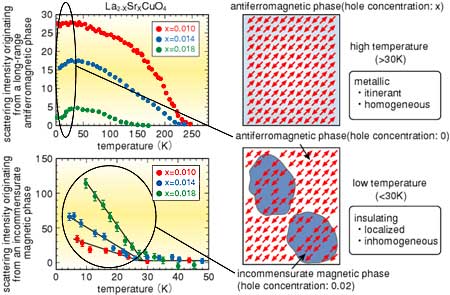Intensive studies have been performed toward identifying the mechanism of high-Tc superconductivity. A common building block in all the high-Tc superconductors is a two-dimensional network formed by copper and oxygen ions. The copper ions have magnetic moments, which show an antiferromagnetic spin correlation. With hole doping, some of the holes become mobile, and superconductivity occurs in a finite range of hole concentration. It is suggested that magnetic interactions play an important role in realizing high-Tc superconductivity. Therefore, it is important to investigate magnetism in the high-Tc superconductors.
Neutron scattering is an important technique for studying magnetic structure. Using the neutron scattering technique, we are currently investigating an interesting subject, that is, the relationship between magnetism and electronic transport. We have performed neutron scattering experiments using single crystals of La2-xSrxCuO4 (0<x<0.02). At high temperatures (T>30K), where the system shows metallic behavior, magnetic moments exhibit antiferromagnetic ordering. With decreasing temperature, holes gradually become localized. We have found that the holes are not localized homogeneously, but phase separate into a hole-rich region (~2%) and a hole-poor region (~0%). The hole-poor region shows long-range antiferromagnetic order. On the other hand, the hole-rich region shows a short-range incommensurate magnetic order with a periodicity ~25 times larger than the Cu-Cu distance. This effect probably originates from hole ordering.
These results represent the most direct observation to date of electronic phase separation in lightly-doped antiferromagnets. Importantly, this behavior is similar to what was predicted for lightly-doped holes in an antiferromagnet in the absence of long-range Coulomb repulsion. Such a phase separation is realized when hole pairs gain more magnetic energy than the Coulomb energy they lose. |
